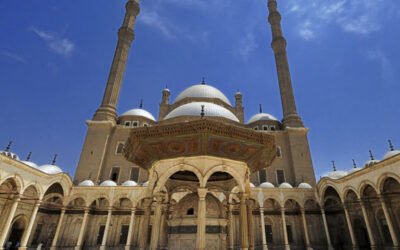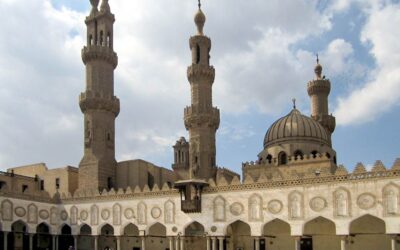Al Rifai Mosque
Al Rifai Mosque
- The Al-Rifa’i Musjid is located in Citadel Square, next to the Cairo Citadel. Its name comes from Ali Abu Shubbak, who is buried in the Musjid. Now, it also serves as the royal mausoleum of Muhammad Ali’s family. The building sits opposite the Musjid-Madrassa of Sultan Hassan, dating back to around 1361, and was designed to complement the older structure as part of a large effort by Egypt’s 19th-century rulers to connect themselves with the earlier periods of Egypt’s Islamic history and to modernize the city.
- Originally, there was a small 12th-century Fatimid-era Musjid on the site, known as the Al-Dakhirah Musjid. Later, the grandson of Ahmad al-Rifa’i, Ali Abu Shubbak al-Rifa’i, was buried there, and it was transformed into a Zawiya for the Rifa’i tariqah. This Zawiya became known as the Al-Bayda Zawiya and not only housed the tomb of Ali Abu Shubbak but also included the tomb of another Sufi mystic, Yahya al-Ansari.
- The present structure of the Al-Rifa’i Musjid was built in two phases between 1869 and 1912 when it was finally completed. It was initially commissioned for Hoshiyar Qadin, the mother of the 19th-century Khedive Isma’il Pasha, to expand and replace the old Zawiya. Hoshiyar ordered an extensive renovation of the Zawiya, and so the original structure, except for the graves of Ali Abu Shubbak and Yahya al-Ansari, was demolished. The new structure was also intended to house the burial place of the Khedive family.
- The original architect was Hussein Fahri Pasha, a distant cousin of the dynasty founded by Muhammad Ali of Egypt in 1803, but he died during the first phase of construction. Work was halted after the abdication of Khedive Isma’il Pasha in 1880. Hoshiyar Qadin herself died in 1885, and work did not resume until 1905 when the new Khedive, Abbas II of Egypt, ordered its completion. Construction was supervised by the Hungarian architect Max Herz, head of the Committee for the Conservation of the Monuments of Cairo.
- The Musjid is the resting place of Ali Abu Shubbak, an important saint of the Rifa’i order who is also regarded as one of the Ahl al-Bayt.
- It also contains the royal mausoleum of the Khedive family, where Hoshiyar Qadim and her son Ismail Pasha, as well as other members of Egypt’s royal family, including Sultan Hussein Kamel, Sultan and King Fuad I, and King Farouk, are buried. Khedive Tewfik and Khedive Abbas II Hilmi, however, are buried in Qubbat Afandina, a mausoleum built in 1894 in Cairo’s Eastern Cemetery, together with other late members of the Muhammad Ali Dynasty.
- The Musjid served briefly as the resting place of Reza Shah of Iran, who died in exile in the Union of South Africa in 1944, and was returned to Iran after World War II. Part of the burial chamber is also occupied by Reza Shah’s son Mohammad Reza Pahlavi, who died in Cairo in July 1980. He was buried in Cairo following the Iranian Revolution of 1979.




